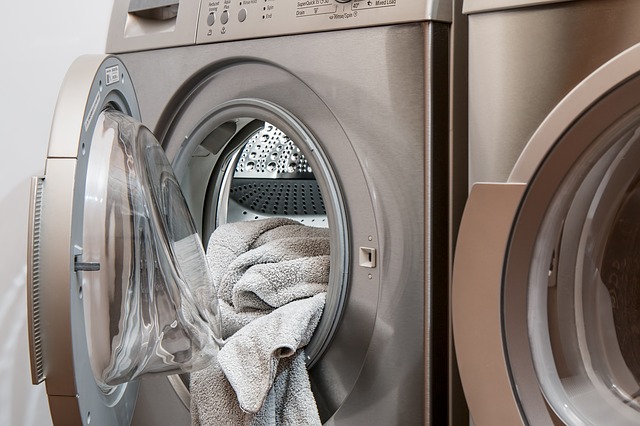Months and even years of build up lint can not only cause your dryer to dry less efficiently costing you money but it can very dangerous. According to the National Fire Protection Association, about 17,000 home dryer fires occur every year. An alarming 34% of home dryer fires are caused by failure to clean dryer vents. While the removable lint filter catches most of it, lint still bypasses the filter and gets trapped in the dryer’s venting system.
Signs of a Clogged Dryer Vent
- Clothes take longer to dry or are still damp after drying cycle
- Outside of the dryer gets extremely hot
- Clothes have a musty odor after drying cycle
- An excessive amount of debris on the outside of vent opening
- The room gets unusually hot when the dryer is running
- A burnt smell is present when using the dryer
- Outside exhaust flapper does not open properly
- Clothes are very hot to the touch
How To Clean Dryer Vent
What You’ll Need
- Vacuum with a long hose attachment
- Dryer vent brush kit
- Soft bristle brush/bottle brush
- Dish soap
- Screwdriver
- UL-listed metal foil duct tape
Directions
Remove the Lint Filter and Clean Thoroughly
Remove the lint trap as you usually would. Pull away lint and take it to the sink and let warm water run on the screen. Then, gently scrub it with dish soap and a soft bristle brush–a brush with hard bristles will puncture the screen. When you’re done cleaning it, set aside.
Clean Inside Lint Filter Compartment
Vacuum inside the lint trap housing using a skinny attachment. Follow your initial vacuuming with a pass of the dryer brush. Using a twisting motion, pull out the brush to sweep out lint and dust. Then, vacuum the brush clean. Repeat this process until all of the lint is removed from the compartment. Lastly, place lint trap back into its housing.

Vacuum inside the lint trap housing using a skinny attachment. Follow your initial vacuuming with a pass of the dryer brush. Using a twisting motion, pull out the brush to sweep out lint and dust. Then, vacuum the brush clean. Repeat this process until all of the lint is removed from the compartment.
Disconnect the Dryer
Safely disconnect your dryer by unplugging its power cord, and for gas dryers, turning off the gas valve. Those with a dryer that runs on natural gas, be sure to be extra careful, you don’t want to disturb the dryer’s gas line too much. After you disconnect the duct joint, gently pull the dryer away from the wall. Remove the metal tape or clamps keeping the vent pipe hooked to its exhaust.
Vacuum the Duct
Insert your dryer vent brush into each duct. If you have to, join the two 2-foot long segments from your brush kit to ensure your brush reaches the end of the vent. If you don’t have a brush kit on hand, you can use a long-handled scrub brush to get the job done. Using a rotating motion, pull the brush back and forth and sweep out lint and dust. Clean the brush after each sweep with the vacuum. Repeat these steps until duct is clean of lint. Afterward, check the vent cap found at the exterior end of the vent, and ensure that it is clean and works properly.
Reattach or Replace Ductwork
Make sure you attach an adjustable 90-degree elbow at the end of the exhaust and then attach the semi-rigid duct. Attaching it without an elbow cause the duct to twist when the dryer is pushed back to the wall and obstruct exhaust flow. Be sure to never use unlisted metal, foil, or vinyl transition duct, for it is flammable. Attach the semi-rigid ductwork with a 4-inch worm drive stainless steel duct band clamp and tighten it with a screwdriver. Seal duct sections with UL-listed metal foil duct tape–never use plastic duct tape.
Once the ducts are connected, turn on gas valve (if you have a gas dryer) and plug the dryer in. When you push the dryer back against the wall, be sure that you are not deforming the ductwork. Run the dryer to ensure that it is venting properly. Be sure that you thoroughly clean your dryer’s venting system every 6 months.
Benefits of a Clean Dryer Vent
Saves Energy

Having a clogged dryer vent wastes ton of energy. To explain, when your vent is clogged the running time increases resulting in a rise in energy expenditure. This could add up to $30 onto your energy bill. On the other hand, a cleared vent ensures that the dryer can run properly.
Eliminates Fire Hazard
As discussed earlier, a clogged dryer vent is a huge fire hazard with lint being the main cause of ignition. By clearing your dryers venting system of lint build up is eliminating this hazard.
Prevents Carbon Monoxide Poisoning

If you have a gas dryer that is not properly cleaned and maintained, you’re increasing the risk of carbon monoxide poisoning. Specifically, when lint clogs the dryer vents, dryer fumes cannot exhaust properly. There’s nothing more important than keeping you and your family safe, so ensuring that your gas dryer is cleaned is vital.
